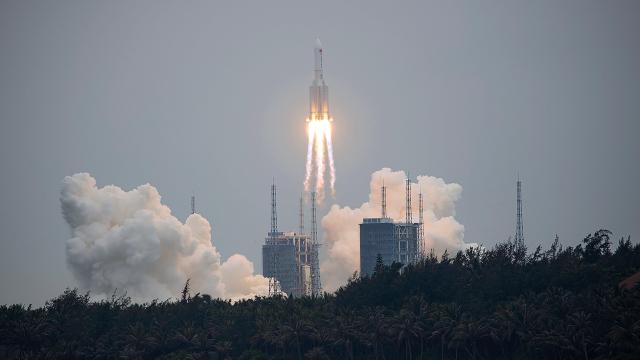The booster from a Chinese Long March 5B rocket reentered Earth’s atmosphere at 6:01 a.m. ET Friday, with debris falling west of the Mexican coast. There are no reports of injuries, but the 22-metric-ton core stage threatened populated areas during its final orbit.
U.S. Space Command confirmed the booster’s atmospheric reentry through Twitter, saying it fell over the south-central Pacific Ocean. Interestingly, Space Command tracked a second atmospheric reentry connected with the Long March 5B rocket, suggesting the rocket snapped into two large pieces.
#USSPACECOM can confirm a second atmospheric reentry correlated with the #PRC’s Long March 5B #CZ5B as it exited the #USSPACECOM Area of Responsibility over the Northeast Pacific Ocean region at 4:06am MDT/10:06 UTC on Nov. 4. https://t.co/keJdc1tmxi
— U.S. Space Command (@US_SpaceCom) November 4, 2022
The odds were good that the 32.92 m-long (33-metre) booster would come down over the ocean, as two-thirds of Earth is covered in water. Still, China is choosing to play with people’s lives and property, designing a rocket that, instead of performing a safe and controlled reentry after launch, flies into a rapidly decaying orbit. The rocket, carrying the third and final module for China’s Tiangong space station, launched from Wenchang Space Launch Centre in Hainan on October 31. This marks the fourth occasion that a Long March 5B rocket has entered into an uncontrolled state.
Final trajectory for the CZ-5B core stage that #reentered over the eastern Pacific Ocean today: pic.twitter.com/BemiR8l8pu
— Dr Marco Langbroek (@Marco_Langbroek) November 4, 2022
Mission controllers had no way to control the booster once it entered orbit, forcing experts to predict where and when it might land, which is notoriously difficult to do. By yesterday evening, most projections had the booster reentering around 12:00 p.m. ET today, give or take a few hours. The rocket, falling at 6:01 ET this morning, fell well in advance of the estimates churned less than a half day before it finally dove into the atmosphere at speeds reaching 28,164 km per hour (28,160 kilometers per hour).
Debris fell to the east of the Mexican coast, near 2.2 S 114.1 W. The booster was moving in a northeastly direction at the time, and had it kept going it would have flown over Mexico and parts of the United States. Debris footprints aren’t small, with widths often reaching 44 miles (70 km) wide and over 1,240 miles (2,000 km) in length, Ted Muelhaupt, a consultant with Aerospace’s Corporate Chief Engineer’s Office, told reporters on Wednesday. Muelhaupt said that between 10% and 40% of the booster was likely to survive reentry.
In fact, possible but not likely that debris could have made it as far as Tabasco province.
However, no reports yet of debris found.— Jonathan McDowell (@planet4589) November 4, 2022
During its final orbit, the core stage flew over Spain, Saudi Arabia, and western Australia. Spain temporarily closed part of its airspace as the booster flew overhead, according to Reuters. No one was hurt (as far as we know), but the wayward booster did result in inconvenience.
This is the fourth incident involving an out-of-control Long March 5B core stage. Two years ago, debris from the inaugural launch of the rocket fell onto the Ivory Coast, reportedly causing damage to property. Debris from the second flight fell harmlessly into the Indian Ocean, but the reentry from the third flight in July 2022 was visible from Malaysia, with dangerous bits of space junk raining down onto parts of Indonesia and Philippines.
More: After 3 Months in Space, China’s Mysterious Spaceplane Ejects Unknown Object.
